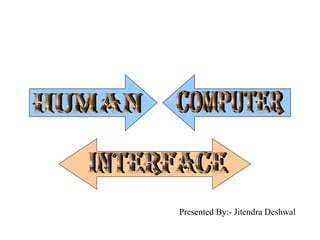
HCI
- 1. Presented By:- Jitendra Deshwal
- 2. OVERVIEW • Introduction • Definition • Importance of HCI • Disciplines contributing to HCI • Description • Model of HCI • HCI design models
- 3. INTRODUCTION • Human factors related to computer can roughly divided into topics related to hardware design & topics related to design of the software interface • Hardware should be designed to maximize task performance. • Software interface refers to the information provided by the computer and the control mechanisms for information inputting
- 4. HUMAN - COMPUTER INTERFACE Human the end-user Computer hardware software
- 5. Interface • A point where two objects meet. • A point where the human can tell the computer what to do. • A point where the computer displays the requested information.
- 6. Interfacing
- 7. Importance of HCI • Productivity – individual (e.g. installations, word processing) – organizational (changing job content, satisfaction, working environment, power and influence) • Safety (e.g. nuclear plants, flight control)
- 8. Disciplines, contributing to HCI • Computer science • Cognitive psychology • Social & organizational psychology • Ergonomics • Artificial intelligence • Linguistics • Philosophy, sociology, anthropology
- 9. Computer Match • A good interface match would include as many senses as possible. • Computer input and output is basically seeing what we enter and what is displayed. • Sound can be added to some programs, either by giving instructions by voice, or listening to a commentary / music. • Touch can be in the form of using the mouse, a joystick, or a drawing tablet.
- 10. Virtual Reality • Virtual Reality is a computer interface. • The applications programs combine the interfaces already mentioned to give a simulated three dimensional world of sight, sound, touch and movement. • Interaction may be made through special equipment such as: spectacles, gloves, sound systems, and the computer and monitor. • As these types of interfaces develop and become more advanced (realistic) through high level programming, so the human use will become more common and so it will seem to be similar to communication with other humans.
- 11. Natural Language • Normal speech recognised by a computer is Natural Language Interface. Talk to a computer and it recognises what we want. • Natural means human-like, and the technology is leaning towards getting computers to behave in a more natural way.
- 12. Graphical User Interface (GUI) • Used on computers first by Apple Macintosh, and afterwards by Microsoft. • The memory and file management are done by the operating system while applications are running – Multi-Tasking. • A mouse is used to point and click on icons instead of typing in a command. • Dialogue boxes, menus, icons, toolbars etc form the window on the computer screen.
- 13. Icons
- 15. Menus (Pop Up)
- 16. Standardisation • The GUI is very similar in different applications. • In an integrated package it will be almost identical from application to application. Word Power Point Excel
- 17. Command Driven Interfaces • Had to type in a command. • The syntax had to be correct. • Difficult for inexperienced users. • Example above: Microsoft DOS, and UNIX. • Advantages: Powerful, Quick, and Flexible. • Disadvantages: Difficult, need experience, Syntax difficult to remember, typing mistakes!
- 18. A model of HCI People Technology Work Level 1 Level 2 Level 3 Social system Organizational goal
- 19. HCI design models • Waterfall model • The star life cycle model
- 20. The waterfall model Requirements analysis & specification System & software design Implementation & unit testing Integration & system testing
- 21. The star life cycle Task analysis / functional analysis Requirements specification Conceptual design / formal design Prototyping Implementation Evaluation
- 22. Eye Tracking Eye tracking is a research methodology whereby a person's eye movements are captured using a camera, and this data is used to track exactly what the participant is looking at. In Human Computer Interaction (HCI) and usability research, eye tracking is used to determine what people look at when interacting with computers. This information is used to make programs and applications that are more intuitive and easier to use.
- 23. Referred websites • IBM HCI design guide at http://www.ibm.com/ibm/hci/guidelines/design • Terry Winograd, Donald Norman
